When your air conditioner unit conks out, or your house is too drafty to maintain a comfortable temperature, a portable AC becomes a lifesaver on a hot day. Once winter hits, it’s time to replace that AC unit with a portable heater.
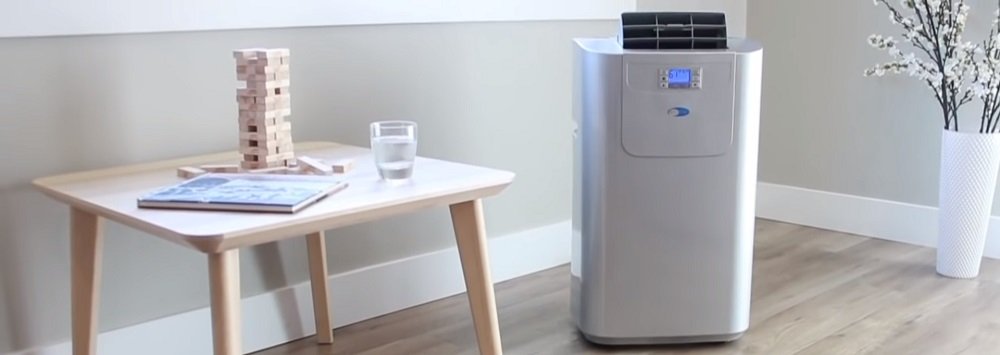
Introduction
For space-challenged homes, storing these portable units during the off-season can prove problematic. However, portable air conditioner and heater combos offer refreshingly cool air and toasty warm heat, solving your heating and cooling needs while freeing up storage space.
How Portable Air Conditioner Heater Combos Function
Many users may wonder how it is possible for the same device to emit hot air on one occasion and cold air on another. The science behind this is similar to that of a heat pump, although air conditioner and heater combinations are not, in and of themselves, heat pumps.
Portable air conditioners are fairly uncomplicated in terms of how they work:
Firstly, they are equipped with a fan to create gusts of air in a particular direction. This air travels along condenser coils or ‘cold coils’, which cools the air and reduces the humidity as well. The heat from the air in the room is directed with refrigerant lines and a thermal expansion valve to copper evaporator coils or ‘hot coils’.
An additional fan ejects any excess heat through a vent which should be situated through a window to the outdoors. There are, however, portable air conditioners that need not be installed at a window and have no vent.
When it comes to an air conditioner and heater combinations, all it takes to change from one to the other is to move the expansion valve to the other side, thereby reversing the direction of the flow of the refrigerant. This is done by simply flicking a switch on the unit or using a remote control to turn on the heating function.
Once the direction of the refrigerant flow has changed, the copper coils will have changed temperature, from cold to hot. In other words, they were, with a quick switch, converted from condenser coils into evaporator coils. During colder weather, the air in the room will travel along the coils, heating the air itself, and this air will exit the system into the room in a recycling motion of sorts.
Our Recommended Portable AC/Heater Combos in 2023
The market is saturated with climate control appliances. These eight models offer the best combination of efficiency, affordability and extra features.
5) Whynter Elite ARC-122DHP
The AC/heater/fan/dehumidifier Elite by Whynter is powerful with its dual-hose setup, boasting 12,000 BTUs of cooling power and 10,000 BTUs of heat production. When using as a heater, you don’t have to go through the hassle of condensation drainage – The auto pump takes care of it for you. This AC/heater can extract up to 76 pints of moisture from the air per day, and you can drain the reservoir manually or continuously.
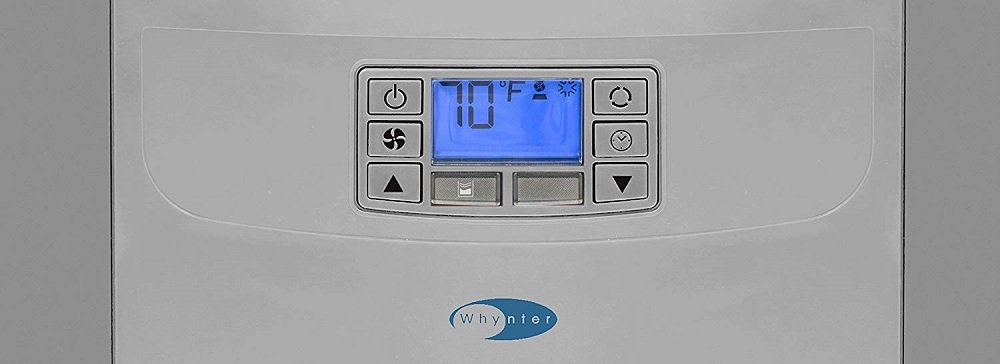
Although the control panel is small and simple, it doesn’t lack in terms of functions. The digital display allows you to set the temperature from 61 to 89 degrees Fahrenheit. It also offers a 24-hour timer and an auto-cycle function. Whynter integrated power-loss memory into the portable air conditioner, so the unit can recall its last-known settings. The AC/heater also comes with a remote for across-the-room control.
The three-speed fan pushes out air at an incredible rate of 155 cubic feet per minute throughout a 400-square-foot space. However, it still manages to operate quietly at 52 decibels on its lowest speed. For allergen and odor control, Whynter includes a washable pre-filter and a disposable activated-carbon filter.
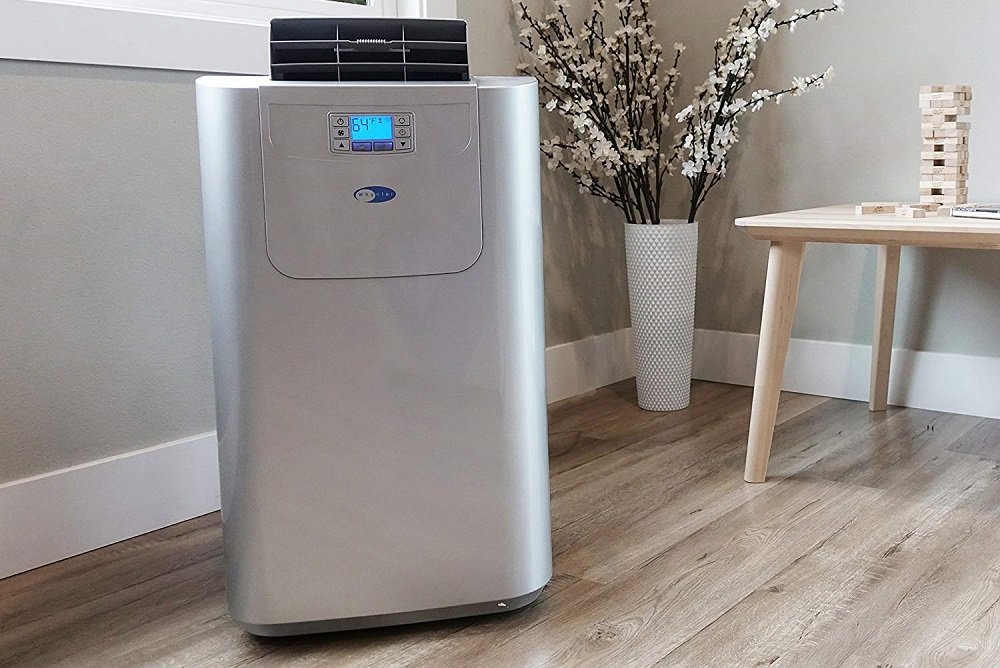
Everything you need to install the Elite comes with the unit, such as the intake and exhaust hose as well as a 20-by-46-inch window kit and a storage cover. Two lifting handles on the sides and one on the rear along with casters help you move the 63-pound AC/heater. Its 6-foot power cord provides enough length to position the portable unit wherever you want.
- AWARD-WINNING: Good Housekeeping's 2022 "QUIETEST PORTABLE AIR CONDITIONER"
- POWERFUL & QUIET: 12,000 BTU (ASHRAE) / 7,000 BTU (SACC) cooling capacity | 10000 BTU...
4) De’Longhi Pinguino 4-in-1 Portable Air Conditioner – Heater
The De’Longhi Pinguino is a smart air conditioner-heater combo that cools, heats, dehumidifies, and circulates air in rooms of up to 500 square feet.
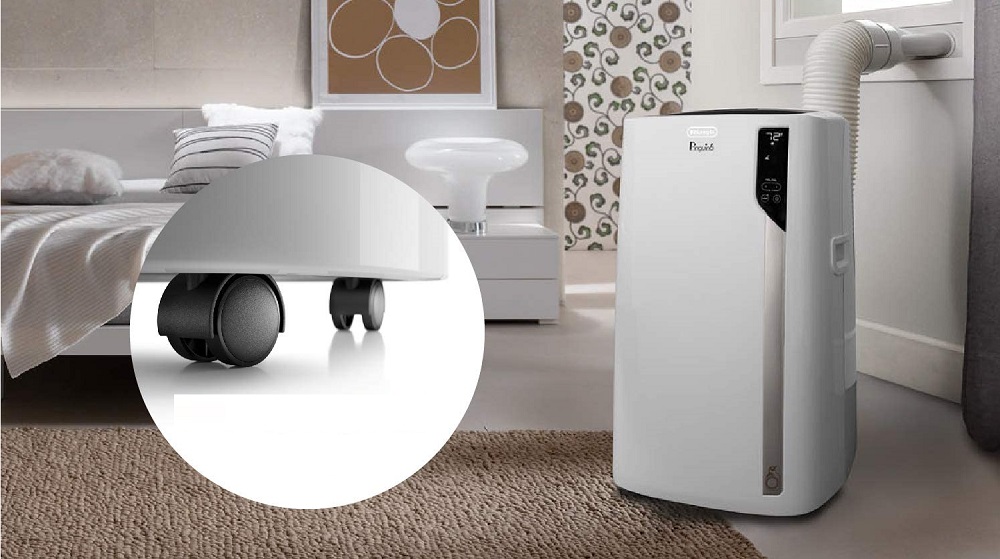
This single-duct portable aircon comes with a nifty BioGS Silver (HEPA-style) filter that traps minuscule minuscules parts from entering your home through the outdoors.
It doesn’t come in a built-in pump, so you’ll have to be wary of how quickly the water-collection tank fills when using the dehumidifier or heater mode. Good thing the De’Longhi PAC app alerts you when the tank needs to be emptied. This 84-pound device sits atop four casters for easy movement from room to room.
- Year-round Comfort — Portable Cooling plus Heating
- COOLS EXTRA LARGE ROOMS. Supplies 12500 (ASHRAE)/7200 (SACC) BRU cooling power where it is...
3) TCL 14PH31 Portable Air Conditioner + Heat
The TCL 14PH31 is a lightweight, portable aircon with heat that also comes with fan and dehumidifier modes.
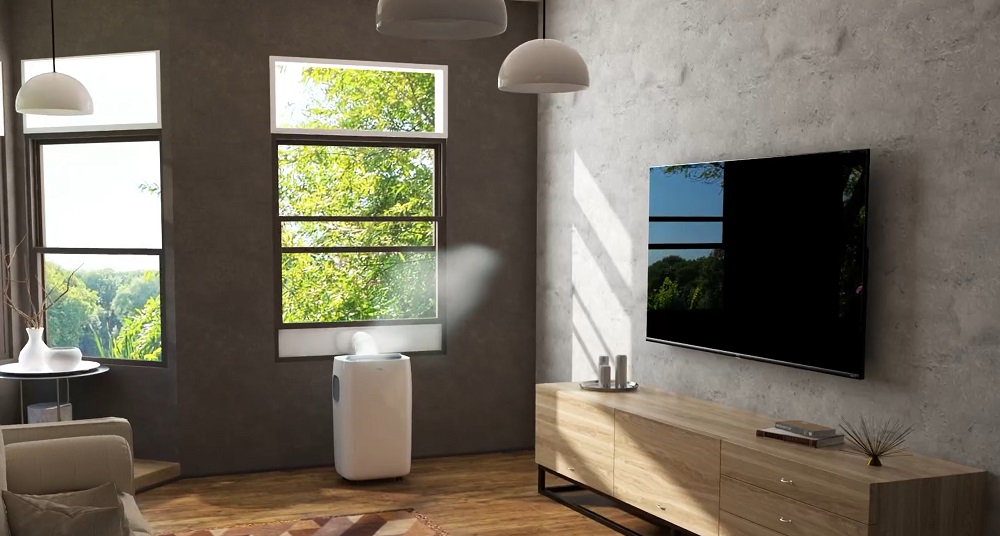
Rated at 14,000 BTUs, it has the ability to cool and heat rooms up to 375 square feet, making it ideal for bedrooms, dorms, and apartments. It comes with a remote control that lets you set the temperature and scroll between modes from a distance.
Setting up this single-hose portable aircon can be done in a matter of minutes. Simply adjust the window kit, run the hose through the kit, and turn the 14PH31 on. While the LED control panel looks awesome, the bright blue lights can be annoying at night time. Sadly, you can’t turn them off.
- 4-IN-1 AC, HEATER, FAN, & DEHUMIDIFIER: The portable 4-in-1 AC, heater, fan, &...
- POWERFUL COOLING & HEATING: Experience year-round comfort with the powerful 14,000 BTU air...
2) BLACK+DECKER BPACT14HWT Portable Air Conditioner with Heat
The BLACK+DECKER BPACT14HWT Portable Air Conditioner comes with a built-in heater that covers up to 375 square feet.
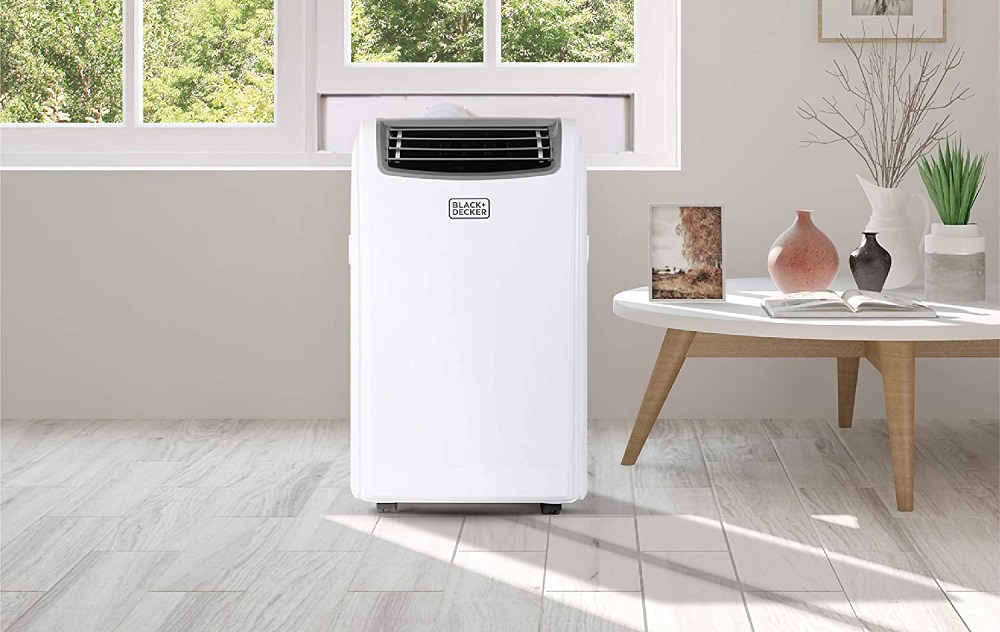
On cooling mode, the reach is limited to 350 square feet, which is perfect for most bedrooms and apartments. On dehumidifier mode, it can remove up to 47 liters of water every hour. Just be mindful of how quickly the tanks fills.
This portable aircon was designed with energy-efficiency in mind. A 24-hour timer, sleep mode, and three fan speeds allow you to heat or cool down small rooms while using less energy than most. Setting up the window kit can be tricky, per user reports, but it only takes 30 minutes at most to get the aircon up and running.
- Portable AC: Use our personal air conditioner & heater (16.5” x 14.06” x 27.09”) in...
- 4-in-1: Our 8400 BTU DOE (14000 BTU ASHRAE 128) portable air conditioner & 11,000 BTU...
1) SereneLife SLPAC Portable Air Conditioner + HEAT
SereneLife offers two portable aircons with heat. This is the 10,000-BTU model that offers four room-comforting modes (cool, heat, dehumidify, fan) that you can scroll through via the handy remote control.
The super-powerful dehumidifier can remove up to 1.5 liters of water vapor per day to get rid of summer mugginess ever so slightly.
The water-collection tank is quite small, but the good news is that you can connect a continuous drain hose onto the end of this unit (sold separately). What’s great about this unit is that you can run both cooling and dehumidifying modes simultaneously. Make sure not to do this too often since it can dry your skin.
- HANDY AND PORTABLE: The Serene Life Portable Air Conditioner System features a...
- BUILT-IN DEHUMIDIFIER: you don’t only get the cooling effect of the portable AC but also...
Buyer’s Guide
Calculating the BTUs
BTUs, or British thermal units, are the measurement used to determine an air conditioner or heater’s power. However, don’t make the mistake of thinking you’re better off with the most BTUs possible. You must match the size of the room to the number of BTUs.
Portable air conditioner and heater combos range from under 10,000 BTUs to over 14,000 BTUs. Every room’s heating and cooling needs are unique, making exact calculations impossible. A good rule of thumb is 20 BTUs per 1 square foot. Don’t forget to increase the BTUs for a sunny or high-ceiling room and decrease for a shady one.
One Versus Two Hoses
Some portable AC/heater combos have one ventilation hose while others have two. A one-hose setup collects warm air from the room, circulates it internally until the air reaches the desired temperature and pushes the air back into the room while the moist air is sent through the hose to the outdoors.
With a two-hose configuration, the air is still pulled into the unit, circulated and released into the room, but the air comes from the outdoors via the intake hose. As its name suggests, the outtake hose releases the moist air back outside.
In terms of how quickly it cools and heats, two-hose portable AC/heater combos are faster. However, one-hose units require less electricity, saving you money on your utility bills.
Understanding the Heat Pump
Many people understand the basics of how a portable air conditioner cools the air, but the heating portion of an AC/heater combo can be confusing. The heating function in one of these appliances works on the heat pump method.
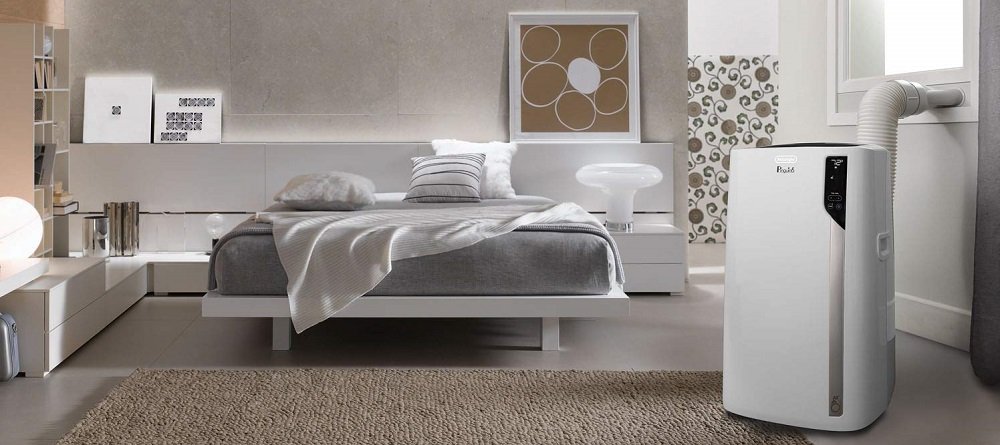
The heat pump works just like the AC portion of a combo unit, but it works in reverse. Inside the unit, there is a reverse valve that changes the direction of the refrigerant’s flow, and the hot air that is usually sent outside is released into the room.
Choosing Where to Vent
A window is the most popular ventilation location for a portable AC/heater. Virtually every unit comes with a window-vent kit, and it’s not a difficult process. Just open the window, insert the sleeve and screw in the hoses.
You can also use a sliding door if a window location isn’t convenient. Although you’ll have to purchase a sleeve extender or two, these pieces come cheap. Still, windows are preferable if you plan to move the unit to another room.
The least popular ventilation option is through a wall, but it’s a feasible choice if the room is connected to a garage. Since you’ll have to cut an opening in the wall, this option may not be suitable if you’re a renter.
Drainage Configurations
To get rid of the accumulated moisture from the air, a portable air conditioner and heater combo will drain in one of several ways. The first method is called the gravity drain. A thin tube that connects to the AC/heater combo is directed downward into a floor drain or container.

Another method uses a pump to move the water upward and through a hose. Then, there are evaporative units. Evaporative models eliminate the condensation through the hot air exhaust. Fully evaporative units take care of all the drainage while partially evaporative combo units have a tray you must empty occasionally.
A Guide to Must-Have and Convenience Features
With a portable air conditioner and heater combo, some features are must-haves while others are mere conveniences. Always choose a model that checks off all the must-haves. Here’s what to look for when shopping for one of these versatile cooling and heating units.
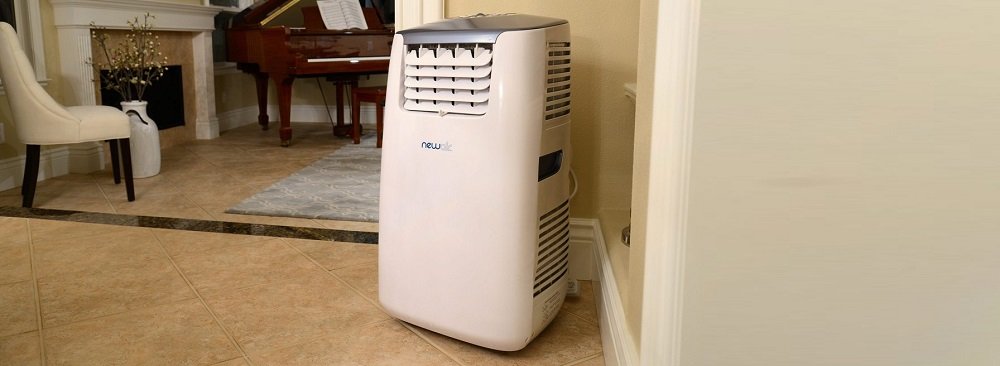
Must-Have Features
The last thing you want is to get a portable AC and heater that doesn’t keep your cool or warm enough. To avoid this problem, don’t low-ball the number of BTUs you’ll need. On a similar note, review the unit’s specs to make sure it’s designed for the size of your room.
Once you buy the AC-heater combo, you must do light assembly to get it in working order. If you don’t want the hassle of buying spare parts, get a unit that comes with an installation kit for the hoses and window.
Do you Need a Window for a Portable Air Conditioner?
Like a central HVAC system, a portable air conditioner and heater should offer a way to change the temperature. Virtually every unit has a programmable thermostat. If you want more control, look for a model with an auto mode or a timer. If you live in a humid climate such as the South, a unit with a built-in dehumidifier is another must-have.
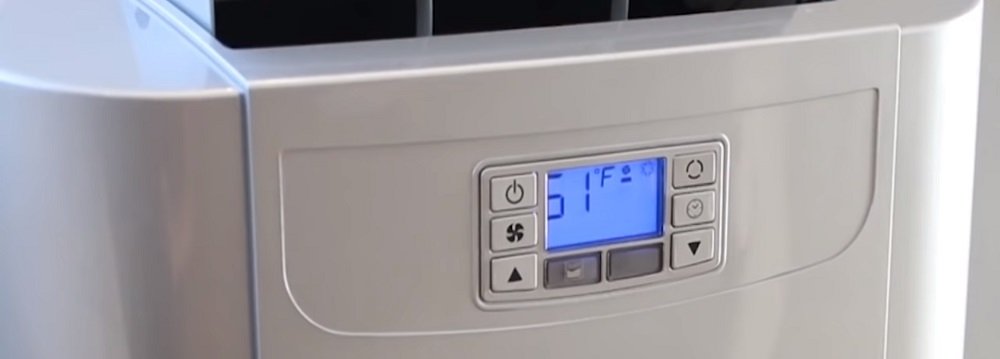
Convenience Features
Certain features fine-tune a portable AC-heater’s efficiency. One feature is a variable-speed fan. With this type of fan, you can lower or raise the air output with the touch of a button. A dual-hose system is another. Not all units come with two intake hoses, but those that do tend to cool a room faster with less effort.
If the unit also has a dehumidifier, there will be one or two options as far as draining the water goes – manual or automatic. Manual draining involves the removal and dumping of a collection bucket while automatic does the draining for you. Automatic, or direct, draining is not necessary, but it is a time-saver.
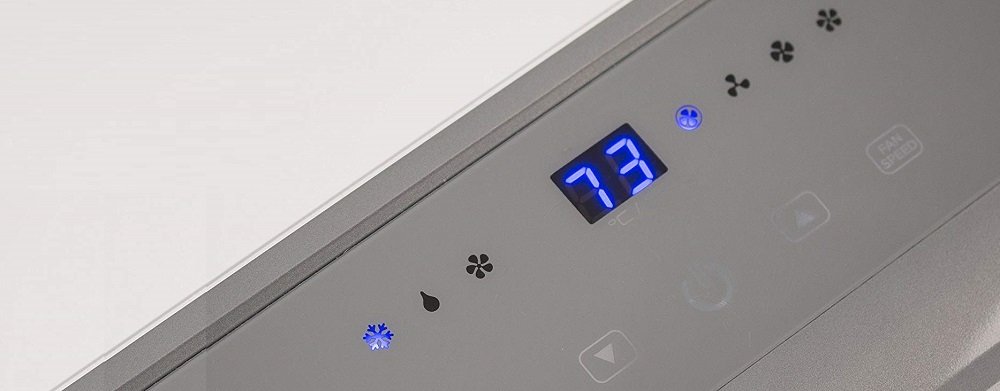
Remote controls are considered a convenience feature. Even though a remote comes standard with most units, you can still do without one and get up to change a setting on your AC-heater combo. Auto restart is another extra. Since there aren’t many functions to set on a combo unit, it only takes a minute to reprogram the thermostat if you experience a power loss.
Related Portable Air Conditioner Articles
Best Portable Air Conditioners
Best Portable Air Conditioner and Heater Combos
Info Articles
Do you Need a Window for a Portable Air Conditioner?
Portable Air Conditioner With Heater Quick Video Buying Guide
In-Depth Explanation of the Features
Cooling Abilities and Size
Size is the first consideration when finding an air conditioner to suit your home, location, and requirements. The EPA has asserted that the correct size is ‘20 BTU per square foot of living space’, which is likely ideal for mini-split AC units and window units, but manufacturers of most portable AC and heater combination units would assert that users will need ‘30 BTU per square foot of living space’ to ensure the best performance possible.
If we apply this estimation by manufacturers for practical use, the equation would be as follows:
Say, for example, we have a 15 000 BTU portable AC and heater combination unit.
15 000 BTU / 30 BTU per square foot of living space =500 square feet.
From the above, we have determined that a 15 000 BTU portable AC and heater combination can cool down around 500 square feet of living space.
It should be kept in mind that these calculations are purely theoretical. The specification manual that should come with the unit you have purchased will recommend area coverage to guide you. These are the specifications you should apply in practice.
Capacity and Coverage
Until recently, a major issue faced by users and manufactures alike was the tendency of the heating component in an AC-heater combination to be significantly less powerful than that of the cooling component.
This problem has been all but solved in recent times, and any combination unit you purchase should yield about the same amount of power on either setting. There is now symmetrical heating and cooling output in modern units, meaning combination units now have an equally strong capacity for both warming a room and cooling it down, and this capacity is measurable.
The ‘30 BTU per square foot of living space’ calculation determined by manufacturers is therefore also applicable for the heating component of modern AC-heater combination units, which means that a 9 000 BTU heating output can heat up a surface area of up to 300 square feet.
This is not to say that this calculation applies to all models. Some producers have better-quality units that completely out-perform these generic calculations. The Whynter ARC-14SH, for example, is equipped with a 13 000 BTU heating component, but can actually heat up spaces of up to 500 square feet, according to Whynter’s technical specification manual.
Electricity Usage and Efficiency
Inevitably, heating and cooling units, and a combination thereof, will require electricity to empower them. It’s therefore useful for users to know how many watts will be needed in order to produce their unit’s output throughout the cooler and warmer seasons.
Users will want to invest in units that are efficient when it comes to energy use, not only because this will save them on their monthly electrical bill, but also because it is environmentally sound to do so. AC-heater combination units with a 10+ EER are, therefore, preferable to generic 8.5 EER units.
One of the most common questions regarding portable AC-heater combinations is whether they have a high electricity consumption rate.
They use no more energy than portable air conditioners and space heaters that are not combined. There are also units that are specifically designed to use less electricity.
Heat, ventilation, and air conditioning units (HVAC) will use between 1100W and 1800W of electricity to yield between 10 000 BTU and 14 000 BTU. When it comes to the heating component, they will use between 1000W and 1700W to yield between 9000 BTU and 13 000 BTU.
An EER rating is used to measure the energy efficiency of the cooling component in portable ACs that are equipped with heating components as well. The EER rating speaks to the ratio between the maximum outputs in BTU to the max cooling wattage.
Buyers should seek out the following EER rating when considering which AC-heater combination to purchase:
A unit with an EER below 8.5 has a below-average energy efficiency rating. A unit with an 8.5 EER rating on the dot has an average energy efficiency rating. A unit with an 8.6 EER rating or higher will have an above-average level of energy efficiency. Units with a 9.5 to 10.0 EER rating are very energy efficient and those with a 10+ EER rating have are incredibly energy efficient.
Buyers should have a high standard for energy efficiency in the units they buy and, when seeking portable AC-heater combinations, should definitely not settle for anything below a 9.5+ EER rating. It shouldn’t be difficult to find units capable of 10+ EER either, which are ideal if your concerns are to save as much energy as possible.
When it comes to the heating component of these combination units, Heating Seasonal Performance Factor (HSPF) is used to measure the energy efficiency of the heating component of the unit. EER is a more mainstream rating unit for energy efficiency, however, and HSPF is used less frequently.
Having considered all of the ways of measuring power consumption and energy efficiency of ACs and heating units, we can consider the best portable AC-heater combinations on the market.
Weight and Size of the Unit
Inevitably, the size and the weight of an AC-heater combination will influence how easy it is to maneuver the unit. Units tend to weigh in at between 45 to 95 pounds. As such, if your home has a lot of stairs, you will want to select a lighter unit so that moving it around the house is manageable.
In choosing the right size for your AC-heater unit, you will also have to consider the size of your living space, and how much of that space you are willing to sacrifice. Units with a width and depth between 12 and 18 inches are ideal.
Adjustable Thermostat
Some units come with variable settings so that the user can determine the temperature being expelled by the unit. An adjustable thermostat is, therefore, ideal if you want more control, rather than having to settle for only a generic hot or cold setting.
Dehumidifying Functions
Happily, most models come with a dehumidifying function, which is great, particularly in humid climates with high levels of dampness in the air. It is important to consider the climate of your location, and whether you are frequently subject to dry heat or humidity, before deciding on which model to buy, as some do not come equipped with dehumidifying capabilities.
Noise Levels (dbA)
It obviously defeats the purpose of having a heating or cooling unit to make your living space more comfortable if you have to deal with a loud buzzing noise the entire time. Most units will have two-decibel ratings. There will also be a different noise level when the unit is starting up as opposed to when it is in the midst of running. Start-up will be significantly louder as the motors and fans start to get going.
The higher the decibel rating, the more unpleasant the noise level, and, therefore, users should pay attention to the noise rating and choose a unit that operates at 56dB or less. To give some perspective on the noise that would be produced from units with this rating, we can compare such a unit to a generic hairdryer, which produces 60 to 63dBA when running at full power at 15 feet, which is very obstructive, in that you cannot converse with members of the household nor enjoy a television show while a hairdryer is running.
If you want to avoid having to shout over the heater at your guests or invest in additional speakers to hear the television, you’ll want to find a unit with a noise rating below 58dB.
Price and Warranties
Pricing of the unit will depend greatly on all the factors mentioned above, like the size, energy efficiency, noise rating, and the like. Portable AC-heater combinations tend to be cheaper than central air units, which is certainly a benefit, but you will need to research, firstly, what kind of unit is most suitable for you and your circumstance, and thereafter consider prices that are within your budget.
You will also have to pay attention to the warranty that comes with each unit, and the terms, conditions, and time frame thereof. Some warranties would require that you keep the receipt, packaging, or registration of the unit. Other warranties will have certain distinct conditions that need to be met, so make sure you read over these carefully prior to purchasing to ensure that you can perform these conditions.
Portable ACs vs Central ACs
While a portable AC unit is great for smaller living spaces, users with homes larger than 400 square feet, who want every room to have air conditioning, should probably invest in central air conditioning for convenience sake.
However, if your home already has central air conditioning, this shouldn’t necessarily prevent you from purchasing an additional, portable unit if you require extra cooling or heating in a particular room as needed.
Homeowners of large houses with many rooms may find that all but a few of the rooms are left unoccupied more often than not. As such, they may set the central heating thermostat to 80F and choose to keep a portable unit in rooms that are used frequently, such as the living room, kitchen, and bedrooms.
Portable AC-Heater Combinations vs Window ACs
Both portable units and window units have benefits and downsides. A benefit of a portable AC-heater combination is that it does not need to occupy a window and, therefore, won’t obstruct your view or a natural light source for the room.
Portable units also come equipped with more features and options for the user and are generally less costly than window air conditioners. Window air conditioners with a heating component have a space heater coil, which uses a lot of electricity and therefore will heighten your electricity bill.
A possible downside of a portable unit, however, is decreased efficiency compared to a window AC -even one with the exact same rating from the American Society of Heating, Refrigerating and Air-Conditioning Engineers (ASHRAE).
When comparing a portable unit with a window unit, both of which may have a 14 000 BTU, the portable AC unit will emit only 7 500 BTUs of heating and cooling output every hour.
FAQs
What’s the Average Lifespan of These Units?
Most portable air conditioner and heater combo units will serve you well for 10 to 15 years. Of course, the lifespan of a specific model depends on the quality of construction and the care it’s given. If you are vigilant about maintenance, and you don’t overwork it, you can get 15 or more years from your unit.
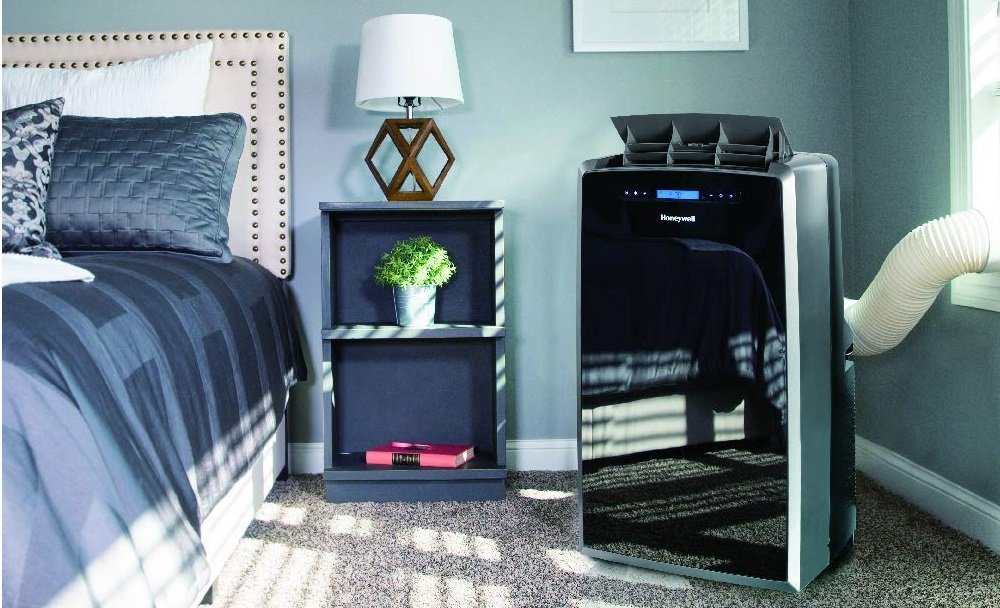
Portable AC/heater combos that aren’t properly maintained may only last 10 or fewer years. The wrong size unit for the room will also reduce a unit’s lifespan due to excessive short-cycling (turning on and off constantly).
Can I Let My Portable AC/Heater Run Constantly?
You can run your portable AC/heater around the clock, but you should avoid doing so when possible. By keeping the unit on constantly, you’ll see a significant rise in your electricity bill. If you run it on cool overnight and the outdoor temperature drops too low, the AC/heater combo may freeze.
To keep your electricity bill in check and your portable AC/heater in operating order, set the unit’s timer to turn on the unit right before you get home. Alternatively, you can just raise the thermostat before you leave and lower it when you come home or program the thermostat to do the work for you.
What’s the Correct Length for a Hose?
Every portable air conditioner and heater combo uses a specific hose-length range, which is determined by the manufacturer. These hoses range from 4 to 8 feet in length. While you can stretch the hose to its longest length, you’ll have an easier time preventing kinks by keeping the hose as short as possible.
If the hose isn’t long enough, move the AC/heater unit instead of getting a longer hose. Although it may seem like a good idea, using a hose that’s longer than the length specified by the manufacturer will have a negative effect on the unit’s efficiency.

How Do I Make My Portable AC/Heater Combo More Efficient?
There are plenty of steps you can take to boost the energy efficiency of your AC/heater combo. Staying on top of filter maintenance is a given, and a tightly sealed exhaust hose will prevent condensation leaks and a subsequent humidity increase. You’ll also want to keep the hose kink and twist-free, so moisture won’t enter the unit.
Where you place the portable air conditioner and heater combo is also important. To maximize the airflow, put the unit about 1.5 feet away from the wall. You should also close the blinds or curtains and turn on the AC/heater before high noon when it’s hottest to limit the radiant heat from the sunlight.
What’s the Best Temperature for a Portable AC and Heater Combo?
The ideal compromise between cost and comfort is a temperature range of 72 to 78 degrees Fahrenheit, depending on the outdoor temperature. Once you reach a temperature in this range that you feel is comfortable, we suggest keeping the AC/heater on auto mode (if it has one).
When cooling a room on hot days, it can take 20 to 30 minutes for the unit to lower the temperature by 15 degrees. If it’s 90+ degrees Fahrenheit when you turn on the AC/heater, you could be waiting for up to an hour to reach a temperature within the recommended range.
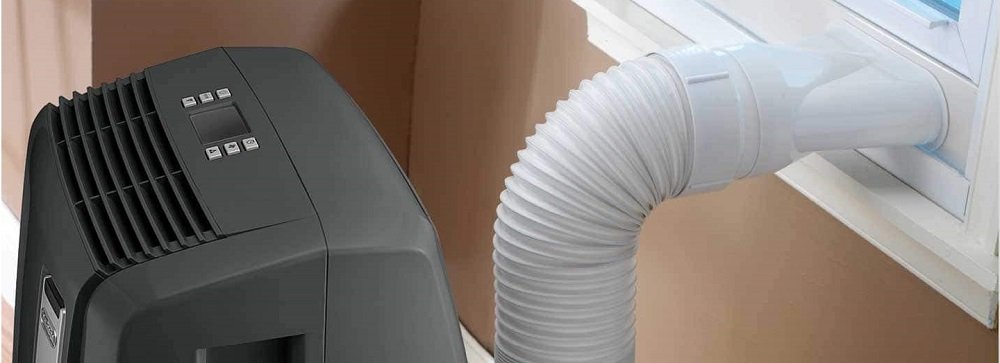
Do You Need to Recharge a Portable AC/Heater Combo?
Unlike fixed outdoor heat pumps and AC units, you do not need to add refrigerant to a portable AC/heater combo. The drainage system maintains its cooling ability, and the compressor is usually sealed.
If your portable unit isn’t cooling like it used to, clean the filter and the coils. Also, prevention is always preferable to repairing or replacing an appliance. Make sure to run the AC/heater combo every once in a while when in storage, so all of its parts stay lubricated.
How Well Do These Units Run in High Humidity?
Humidity is a huge hindrance to a portable AC/heater combo’s ability to warm and cool the air. Basically, humidity counteracts the appliance’s cooling efficiency, forcing it to work harder when the humidity level is high.
On the other hand, low humidity does the unit no favors either. With cold outdoor temperatures, there comes low humidity. If the relative indoor humidity drops below 50 percent, you’ll feel colder than the actual temperature. In turn, you’ll need to increase the AC/heater’s thermostat, which will raise your electricity bill.
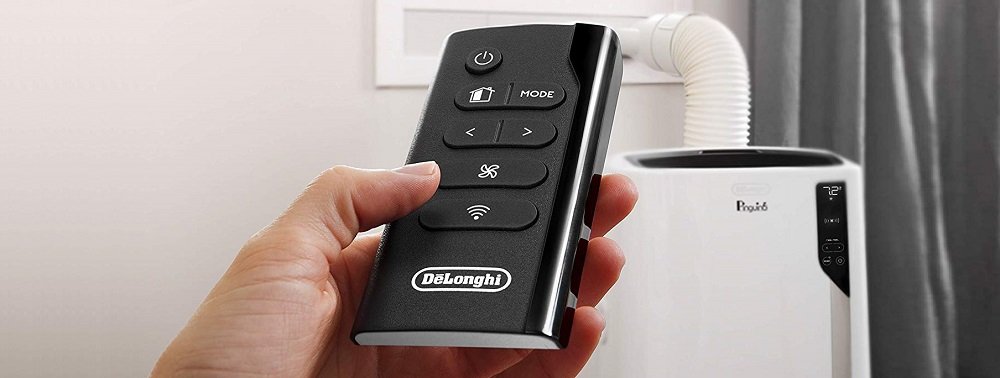
Will I Be Exposed to Carbon Monoxide If I Use These Units?
Due to the lethal toxicity of carbon monoxide, we understand why you asked this question. Thankfully, portable air conditioner and heater combos are safe. These appliances are electrical and don’t produce carbon monoxide. Although some people believe the vents are necessary to exhaust carbon monoxide, their actual purpose is to release hot air.
The only way a portable AC/heater combo could introduce carbon monoxide into your home is if there is a gas-running appliance or a vehicle on the other side of the window, and that is a big “if.” Even if the unit managed to pull in carbon monoxide, the amount would be too minute for it to affect your health.

Does It Matter If I Don’t Vent My Portable AC/Heater?
Venting your portable AC/heater combo a is can’t-skip step. While you may be tempted to forego venting, so you can get your unit set up faster, there are two reasons why you should reconsider.
Inside your air conditioner and heater combo, there’s a compressor and a motor, which create heat as it runs. Without a way to dispel the heat, the room will get hot no matter how low you set the temperature.
Even if you’re wanting to heat the room, we still recommend that you vent your unit. Without a vent, the moisture the AC/heater collects will dampen and eventually ruin the walls and furniture near it.
Are Portable Air Conditioner and Heater Combos Heavy?
These combo units are definitely not lightweight, averaging 60 to 80 pounds. However, they are easy to move as most roll on casters. A lot of units also have a handle, so you can keep them steady during transport. This feature allows you to move the combo unit to another room if necessary.
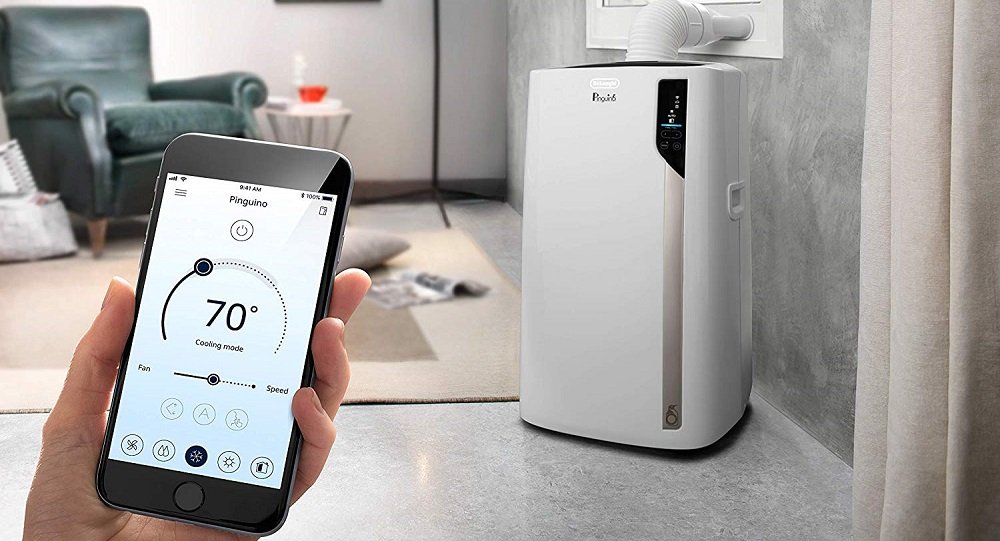
Are Portable AC Units Loud?
Portable units are not noisy – The decibels of sound they make will stay in the 50s, which is akin to the sound of a humming refrigerator or a face-to-face conversation. If you’re sound-sensitive, some models offer a sleep mode.
Sleep mode is a premium function offered on select units. When in sleep mode, a portable unit’s fan runs at low speed to reduce the noise it makes. This is a great feature for anyone who is a light sleeper.
Do Portable AC and Heater Units Use a Lot of Electricity?
With the sky-high cost of electricity usage, appliance manufacturers often cater to customers who are energy-conscious. Therefore, many portable AC and heater combos don’t cost a lot of money to run, especially when compared to whole-house HVAC systems.
Units with a programmable thermostat help you lower energy use. There are even some that have a timer function. If you set the timer, the unit only operates for the length of time specified, so all that cool and hot air doesn’t go to waste when you’re out of the room or away from home.
Can You Program a Portable Unit?
You sure can. Every portable air conditioner and heater combo has a control panel, most of which are user-friendly. From the control panel, you can program the thermostat for precise climate control. Many units are equipped with a variable-speed fan, which lets you determine the output of hot or cold air.
Depending on the model, you can even lower the indoor humidity level, which helps cool a space faster on a hot, muggy day. Some AC and heater combos also remember your control panel selections in the event of a power outage.
Are They Hard to Install?
One advantage a portable unit has that a central unit doesn’t have is that you don’t have to be a certified HVAC expert to set up one. Installation is easy and straightforward. In a few steps, you can attach the exhaust hose, which is thread through your window.
To prevent air leaks, almost every portable unit comes with a window kit. These kits are designed to adjust to the measurements of your window or be cut to size to fit. All you need is a screwdriver, a ruler and a pair of scissors.
How Much Space Can a Unit Cool or Heat?
Several factors come into play regarding coverage area, but the unit’s BTU, or British Thermal Unit, rating is the most important. Essentially, BTUs are a measurement of how much heat an air conditioner can remove or a heater can put out.
Unlike a central HVAC system, a single portable air conditioner and heater combo is not able to cool and heat an entire house. However, a unit with enough BTUs can easily control the temperature in a spacious room of 500 square feet or larger.
How Many BTUs Should an AC and Heater Unit Have?
Sometimes, more isn’t better, and this is the case when it comes to BTUs. While an inadequate number of BTUs won’t cool your room properly, an excessive number forces the unit to work too hard, leading to premature failure. The majority of combo units are effective in rooms from 55 to 550 square feet.
Before you choose a portable air conditioner and heater combo, measure the square footage of the room where you plan to use the unit. Typically, units ranging from 5,000 to 8,000 BTUs are perfect for small rooms. If the room has a lot of windows or a vaulted ceiling, get a unit that produces a little more BTUs than what is needed for a room that size.
Cooling and Heating Capacity
- A 100 sq ft space requires an 6,000 BTU unit
- A 200 sq ft space requires an 8,000 BTU unit
- A 300 sq ft space requires a 10,000 BTU unit
- A 400 sq ft space requires a 12,000 BTU unit
- A 500 sq ft space requires a 14,000 BTU unit
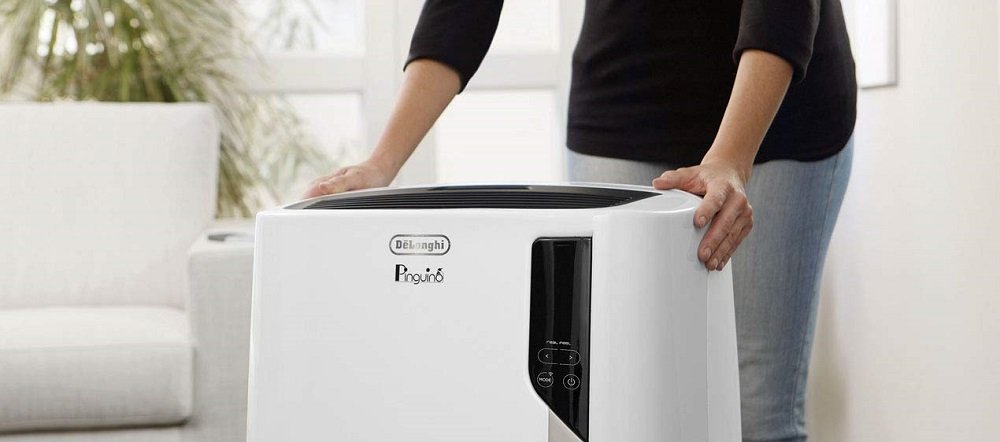
Can Portable Air Conditioner – Heater Combinations be used without being Affixed to a Window?
Yes. Most portable AC-heater models come with collection trays to catch any condensation that formulates in the unit. This tray would need to be emptied frequently. If, however, you have an exhaust hose for ventilation, it can be installed through the wall, window, or ceiling so that the condensation can drip out automatically. As such, you won’t need a window unless this is prescribed by the producer.
What is the Average Lifespan of the Portable AC-Heater Combination?
Even with regular use of a unit, it should easily last between five and ten years. If you maintain the unit, it may even last for an additional five years on top of that. With expert servicing, this becomes even more possible.
Are AC-Heater Combinations Energy-Efficient?
The efficiency of an AC-heater combination depends on its EER. A unit with an EER of 11 or 12 is highly efficient and will save you a lot of cash compared to generic heating units. You may see as much as a $100 reduction on your electricity bill annually if you purchase an efficient unit.
What is the Best BTU Rating for a Unit?
In order to generate the right amount of heat or air conditioning, the unit you purchase needs to have the right number of BTUs for the size of the living space. For smaller living spaces ranging from 55 to 550 square feet, you will need a unit with a BTU rating between 5000 and 14 000.
It should be noted that a higher BTU does not ensure greater cooling or heating capacity on the part of the unit. In fact, too high a BTU compared to the quality of the unit may lead to defects in the unit, as it is being worked beyond its true capacity. You must be very precise in your measurements of the room so that you choose a unit with the exact right BTU capacity.
What Should I do if the AC Component works but the Heater Component does not?
There are a few steps you should go through before you take the unit for repairs. Firstly, check that the thermostat and make sure that its heating temperature is high enough for the system to start up.
If the thermostat requires no alterations, take a look at the filter to see if there is any dirt or debris that could be restricting the airflow. Also, check for any clogging or obstructions at the air registers.
After all of these checks, if the heating component still won’t work, you may be facing an electrical issue and would have to examine the thermostat’s wiring, the circuit breaker, or the heating unit centrally. If there appear to be no electrical faults, the issue is probably intrinsic and you will have to take the unit in for repairs.
Can the Heating Component work without the AC Compressor?
Yes. Because the heating component runs separately from the AC component, the compressor isn’t actually used when heating the room. The fan will blow air over the heating coils which will result in the warm air exiting the unit. As such, if there is a malfunction with the compressor, or it has become worn over time, you should still be able to use the heating component without any concerns.
Does the AC or Heating Component use more Energy?
The heating component will undoubtedly consume more electricity than the AC, although this is impacted to an extent by circumstantial factors, such as the ambient temperature of the room, the weather, the season, and the altitude at the unit’s location.
If the ambient temperature is particularly cold, more energy would be required to heat it, whereas if it is only moderate, less energy will be needed. An air conditioner requires significantly less energy to simply cool the air.
How well do Portable units Operate in Humid Areas?
Humidity certainly influences the abilities of a portable unit, but this is less so in more modern models. Units with condensation trays will simply require that the user manually empty the tray more frequently in a particularly humid climate.
Although evaporative units, in general, do not require manual emptying, they may need it if they are operating in humid conditions.
Recap
Portable air conditioner and heater combos let you heat and cool a room on demand any day of the year. Some come with remotes while others offer Wi-Fi controls. Features such as a programmable thermostat and auto-cycle make it easy to keep your electricity bill affordable.
The most important shopping points to remember is choosing a unit with the right number of BTUs. When you’re ready to set up, make sure the hoses are sealed, and the unit is placed away from the wall. As long as you take care of it, you’ll get over a decade of reliable use from a portable AC/heater combo.
Our Recommended Portable Air Conditioners with Heater
If you have any questions or comments, please add them below in the comment section. Similarly, please let us know if you spot any mistakes or omissions. Thanks!
Last Update: 2024-04-17 | Affiliate links/Images from Amazon Product Advertising API







